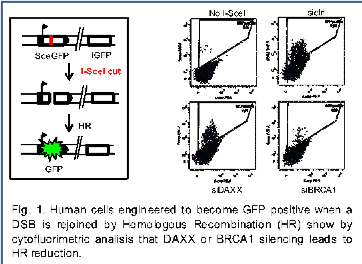Role of DAXX protein and histone variant H3.3 in DNA double strand breaks repair.
The main function of the DAXX protein is to load inside the nucleosomes the H3.3 histone, a variant of the H3.1 classic form. The two histones differ only for 5 aminoacids but this is sufficient to profoundly change their post-translational modifications and their effect on the state of chromatin. In general, the aim of our research is to verify whether and how, in the presence of a double strand break, DAXX and the deposition of H3.3 are regulated. The most dangerous form of DNA damage is represented by double strand breaks and human cells have developed two main molecular mechanisms to repair them correctly: Non-homologous end joining (NHEJ) and Homologous recombination (HR). NHEJ is fast and active at any stage of the cell cycle, but prone to errors. HR, on the other hand, is a slow repair system that can only work in phases S and G2, but is characterized by high fidelity.
We have indications that DAXX’s activity influences the choice of the correct mechanism to efficently repair DNA breaks. In particular, DAXX silencing greatly reduces the possibility of HR repair, as well as BRCA1, a known key factor of this repair system (Fig. 1).

For this reason, we will analyze whether DNA damage response proteins regulate DAXX and DAXX-dependent H3.3 deposition activity. We will also evaluate whether H3.3 accumulates nearby a break and whether H3.3 post-translational modifications can influence the choice between NHEJ and HR when both repair systems are available. We will then evaluate whether ATM protein kinase, known to be a key element of the DNA damage response and mutated in a rare genetic disease called Ataxia Telangiectasia, may play a role in regulating DAXX.
Alterations in DNA repair system choice and the occurrence of genomic instability could, at least in part, explain why DAXX and H3.3 mutations are frequently found in pediatric brain tumors. We will therefore test some of these mutations in human cells to evaluate possible effects on repair. These analyzes would deepen our knowledge of brain tumors which are the second most common form of cancer in children under 15 years of age (after leukemia) and the second leading cause of cancer-related mortality.
